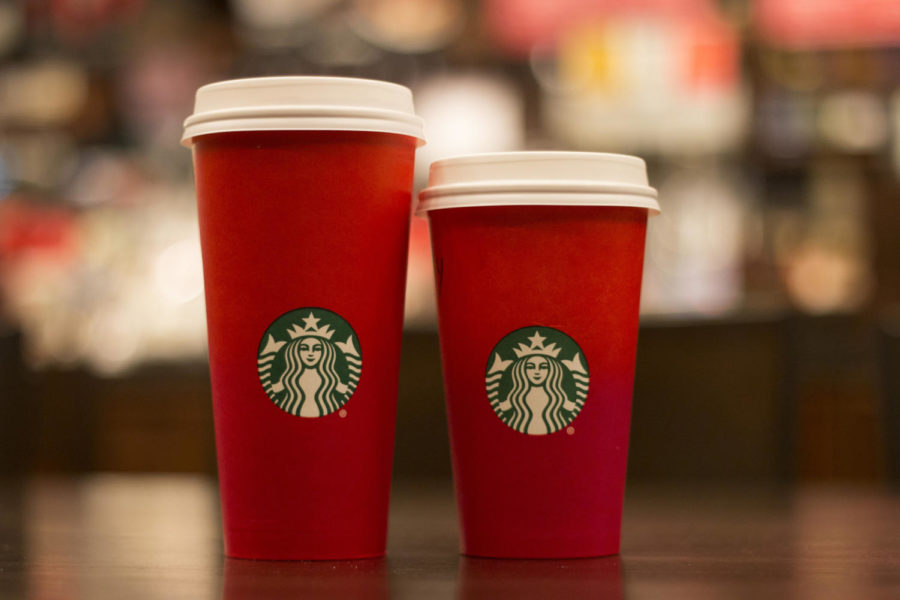Ward: Red cups don’t mean religion
Emily Blobaum/Iowa State Daily
Starbucks has started to use red cups with their drinks as of late October to represent the holiday season.
November 11, 2015
This Starbucks cup can’t talk, which is unfortunate because I would love to hear its take on the controversy surrounding its change in design. But if it could, I would imagine it would sound something like, “No one told me when I signed up for this job that I would be fighting at the forefront of America’s battle with a loss of faith, with the misguided mindset that for it to be true it has to be shown on the outside. So they’re mad at me for not reminding them about their beliefs? Maybe they should be mad at themselves for not remembering how to believe on their own.”
As its voice for the next few hundred words or so, I couldn’t agree more.
We should not be putting a company on blast for a cup design that doesn’t remind millions of lost people that it’s the time of year to act religious again.
Starbucks released its traditional holiday season reminder with its 2015 holiday cup Oct. 22. And if it hadn’t been made clear enough before, the outrage that ensued after the release only showed me that genuine religious belief has been replaced with over-sensitivity and confusion.
Starbucks has been spearheading the tradition of some variation of a red cup with holiday iconography since 1997, each year with a new design. But much to the dismay of just about everyone, there is no design for 2015, just a dark poppy color fading to a dark cranberry. Starbucks’ news website attributes the design to “embracing the simplicity and the quietness of [the holidays]. It’s a more open way to usher in the holiday.”
So naturally people are saying Starbucks hates Jesus.
I would just like to point out that Starbucks has never had a cross on its cups. Mary and Joseph have never been depicted sipping peppermint mochas together, and baby Jesus has never had the privilege of getting printed laying in a manger next to a Starbucks logo.
There have been snowmen, a person sledding, some holiday decorations and this year’s solid color design. None of these images are inherently religious, just a reminder of the season. And by season I mean weather, not a holiday.
This logic is similar to me saying if I don’t wear a Christmas sweater, ugly or not, that I am not a Christian. The only way anyone seems to believe anything anymore is if they see it outwardly expressed.
Based on public outcry, it’s clear from where the general population is basing its religious argument.
Oh no, there are no drawings of gifts on the Starbucks cups this year. Starbucks must hate Christians. Sarcasm intended.
I view this as a misinterpretation of symbols and how long we’ve let holidays and Christianity be interchangeable.
Gifts don’t only go under a Christmas tree, snowmen don’t imply Christianity and snow does not mean Christmas. Sure, these symbols are often associated with the holiday but they do not take the place of what it means to be Christian.
If the company had customarily been printing content with heavy religious connotations on its cups, I could understand the current state of anger being displayed across the country. That act could legitimately be viewed as a stance against Christianity, but the act at hand cannot.
Nothing is being taken away from people who celebrate Christmas. If anything, individuals of other religions are now being more included. It’s a blank slate, not a slight against Jesus.
But perhaps my favorite counter argument in all of this is the fact that this campaign is in response to the company wanting to be politically correct in the eyes of its customers. Being politically correct means being unoffensive and nondiscriminatory. What on earth is less offensive than a snowman?
Saying this campaign is happening because Starbucks is afraid of openly being Christian would clearly imply that the company used to be openly Christian, which it never has been.
The only place I can truly attribute this to is our displacement of belief: the mistake that symbols and the tradition of a cup means Christmas and Christianity.
So here I sit, at a small table with the bustle of people around and the smell of coffee in the air — not a Bible or crucifix in sight. No one is praying for me to see just how evil a plain red cup is. It’s just me, my thoughts about this persisting misinterpretation and this little red cup.

















